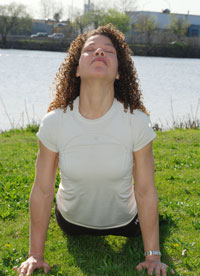
July 2, 2009 – Vol. 3 • No. 11
|
|
|
|||||
Balancing mind, body and soulFor years, Angela Hofmann refused to take a yoga class. Even though her friend was an expert and yoga instructor, Hofmann wouldn’t take her up on repeated offers.Finally, about seven years ago, she went to her first class. She liked it but didn’t consider yoga an integral part of her life. All that changed about three years ago, when she explained that she started “feeling the benefits.” She is now a convert. “Now that I do it,” she said, “I will never not do it. The inner strength it gives me, I don’t want to be without.” Hofmann knew about the health benefits for years. She knew that the low-impact exercise increases strength and flexibility, and affords emotional balance. She also knew that yoga helped with stress. And stress relief was something that Hofmann knew she needed. Hofmann, 47, had suffered with uterine fibroids. The physical discomfort was at times overwhelming. She experienced abdominal swelling and excessive bleeding. And worse, she didn’t know how to resolve it — even after consulting with several doctors. The stress of dealing with the uncertainty merely aggravated her physical symptoms. And the personality changes didn’t help much either. Hofmann tells the story of a family trip to Nantucket. The setting was idyllic; everything was perfect. But you would have never known that from Hofmann’s attitude. She complained about everything. “Everything was wrong,” Hofmann remembered. The vacation proved to be a turning point. She began to take her yoga classes more seriously and was shocked at the results. “Your mind is in a different place.” she explained. “Your mind is clear and can focus better. I walk out of class with a different perspective. I even feel two inches taller. “There’s a letting go of stress,” she added. “When you re-examine what caused the stress in the first place, you realize it wasn’t as bad as it seemed.” What’s more, according to Hofmann, the impact lasts not for just an hour, but for a few days. “The more you do it, the longer it lasts,” she said. That’s music to the ears of Dr. Herbert Benson. Almost 40 years ago, he bucked the medical system when he publicly supported the mind/body concept and the relaxation response. “At that time, medicine was only drugs and surgery,” he said. But when Benson, a cardiologist, found that the relaxation response reduced metabolism, rate of breathing and heart rate and lowered blood pressure, he was hooked. Benson is now the director emeritus of the Benson-Henry Institute for Mind Body Medicine at Massachusetts General Hospital (MGH). According to Benson, the relaxation response balances the physiological changes that occur in response to stress. The core of the response is repetition — of a sound, word or phrase, prayer or movement — and the setting aside of intruding thoughts. An example is sitting quietly twice a day for about 20 minutes, completely relaxed, and breathing deeply while repeating your chosen focus. “This in essence breaks the train of everyday thinking,” said Benson, and enables a person to respond to stressful situations more effectively. “No drug or surgery can compete with that.” Research continues to support the relaxation response. In a recent study conducted at MGH and Beth Israel Deaconess Medical Center, researchers found that the relaxation response impacted the expression of certain genes that control inflammation in the body as well as the handling of free radicals that can damage cells and tissues — the same genes responsible for stress-associated changes in the body. According to Benson, this research suggests that the relaxation response not only works but may have lasting physiological effects on the body. Benson is quick to point out that there are many techniques available to help elicit the relaxation response — deep breathing, meditation, yoga, tai chi, exercise, religion, laughter. Even singing can be therapeutic. “If one technique does not work for you, try another,” he advised. “Some people really can’t sit still too long. They will probably do better with yoga that allows them to move.” It’s hard to get Miriam Eubanks of Yoga with Mimi to stop for a few minutes — she’s a blur of motion and activity. But when it comes to yoga, she always makes time. “Yoga means union,” explained Eubanks, a yoga instructor. “It’s a bringing together of mind, body and spirit or breath. Breathing is a very important part of yoga and the postures help balance the hormones. It makes you calmer.” The key is the deep breathing. “It brings oxygen to the blood and energizes the body,” she said. “Breathing helps relax you and makes you focus better. It helps settle you down.” Hofmann knows exactly what Eubanks is talking about. She practices every day by herself and attends two classes a week. She’s a walking ad. “I’m reprogrammed,” she explained. “I can take things in stride.” She also remembered another benefit. “I don’t get sick anymore,” she said. For yoga to reduce stress, click here |
|
||||






